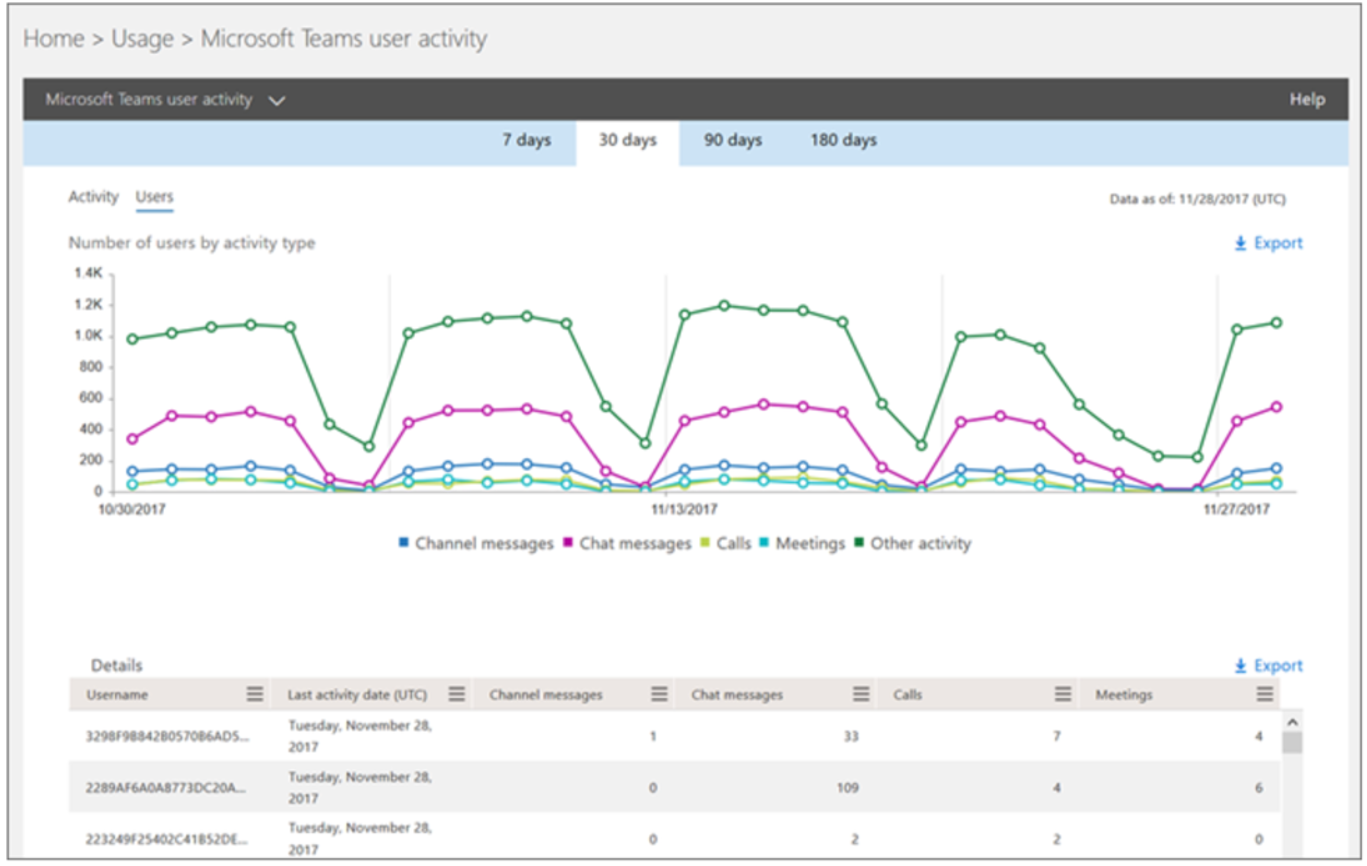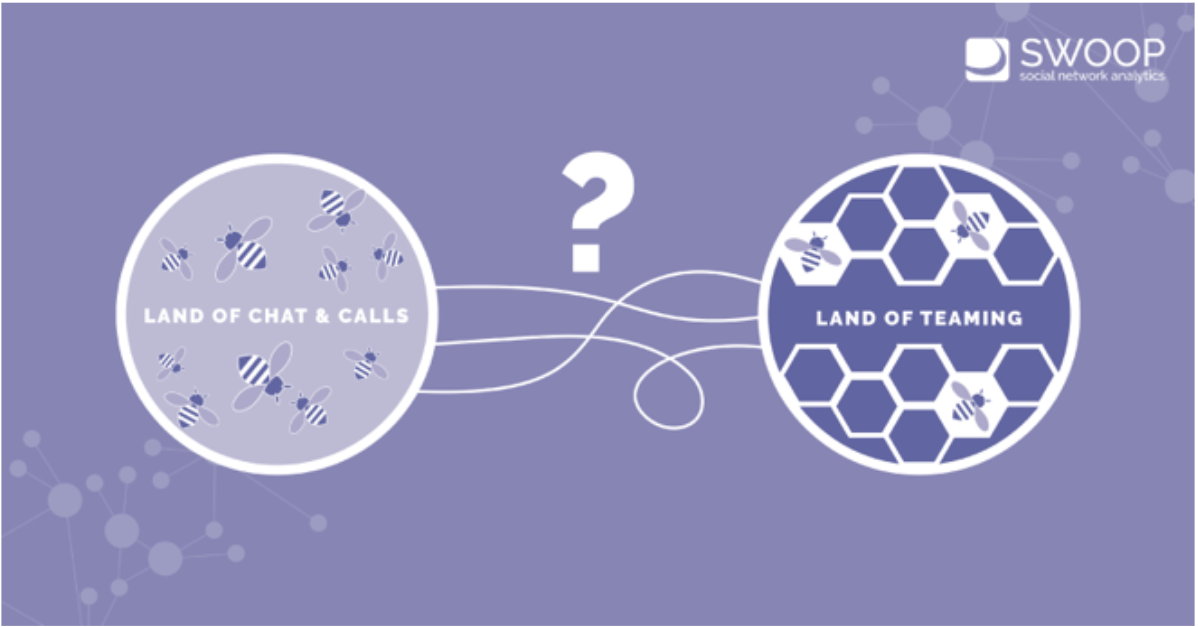All the buzz on Microsoft Teams
In our recent Microsoft Teams Benchmarking report we used the analogy of bees and beehives to describe how people were using (and not using) Microsoft Teams. With the emergence of COVID-19 induced Working From Home (WFH) the buzz has certainly escalated substantially. But why is the bee analogy so important to the productive use of a tool like Microsoft Teams?
Our bee analogy suggests the team channel (digital team) functionality is akin to the beehive, where the fruits of the collective labour materialise. The chat and meeting functions are positioned as similar to worker and scouting bee behaviour (often the buzz we hear while walking around). In Microsoft Teams these functions are largely structurally independent of team channels, and often work independently of each other. This is not the case with bees!
Why do we study bees?
There is something about the buzz of bees that excites us. Buzzing bees connote that industrious work is being done, intense message exchanges and, at times, a warning not to get too close and threaten the fruits of our labour. In a business context, it sends a message that enthusiastic work is being done and knowledge is being shared. SWOOP client Humana, a major US health insurer, even called its company-wide social network, now hosted on Yammer, the “Buzz”. Buzz recently celebrated its 10th birthday.
The fact bees have “swarm intelligence” has not been lost on the research community. Cornell professor and biologist Thomas Seeley applies the study of bees to understand how groups can more effectively co-operate and collaborate. Seeley suggests; “Living in groups, there’s a wisdom to finding a way for members to make better decisions collectively than as individuals”. The artificial intelligence community has also seen the power of distributed and collective intelligence at MIT. The study of bees and swarm intelligence has even been proposed as a solution for charging electric cars on the fly.
At SWOOP we have identified a distinct move toward self-management within teams as staff have migrated to remote work. With less direct intervention from authoritative line management, such groups have to discover means for collaborating between teams; a form of swarm intelligence, if you like.
Developing “Swarm Intelligence” with Microsoft Teams
To develop a “Swarm Intelligence” within Microsoft Teams requires a clear connection between the Team Channels (the Hive) and the Chat, Calls and Meeting (pollinating, scouting). While for bees the hive is a natural home to return to, this is not currently the case with Microsoft Teams usage. In fact, in the early transition to WFH, the easiest way to engage with Microsoft Teams is as an electronic meeting service, requiring the least disruption to existing “in the office” work practices.
The Microsoft Administrators dashboards provide some insight into the use of the different communication channels:
For example, the above report provides activity levels of the different channels down to the individual user. This type of reporting is essentially reporting on resource utilisation. It might be informative to understand the relative activity usage but it can also be misleading as a measure of productive use. For example, the above chart is comparing, say, a chat message with a threaded discussion post, with an audio call, with a video meeting. We might find that for every meeting we have 1,000 chat messages; for every call we have 20 channel messages; but how useful is this when looking to predict team performance?
The key metric is how bees communicate with each other
Back to our bee analogy. The swarm intelligence attributed to bees is due to the way they can self-orchestrate their activities towards a common purpose. The key metric is about how bees communicate with each other, more so than their individual wing beating and body waggling frequency. The common purpose is feeding the hive (team channel space). This is where the fruits of their collective efforts become both visible and tangible.
In the Microsoft Teams context, not all staff are solely focused on a single team. Our benchmarking identified, on average, staff are members of three teams; and for some staff far more than three. Could multi-team membership potentially divide staff attention to the extent that all teams suffer?
While it is possible to hold meetings within a team channel, more regularly, calls, meetings and chat activity are not directly attributable to team activity. In many cases, staff who are active in chat, calls and meetings are not active at all in Teams channels. This is akin to worker bees being dissociated from their hives and therefore the fruits of their labour being essentially lost.
You might rightly suggest that humans aren’t bees and business value is not exclusively the purview of the digital team (hive). Staff can contribute to the business as an individual contributor. Chat, calls and meetings are still collaboration and potentially adding value, even if not connected to a digital team. Isn’t this still teamwork?
We would argue that just because you use Microsoft Teams does not make you a real team. The value of ‘Teaming’ as the preferred mode of collaborative performance is now without question. Former Harvard Professor and acknowledged Team performance expert J. Richard Hackman spoke about what he called the “real team”; bemoaning the loose attribution of the term to non-team groups. As ludicrous as it sounds, Hackman found that knowing who was actually in the team, and who was not, was a key trait of identified high performing teams. For Microsoft Teams, Teams channels should be the home for “real teams”. Staff participating in chat groups, calls and meetings that cannot be formally attached or aligned to a Teams channel space run the risk of diluting the potential benefits that effective teaming can bring.
Practical steps for being a “real team” on Microsoft Teams
In our Microsoft Teams benchmarking report we undertook a comprehensive review of the academic literature on high performing teams to identify their common traits, and then matched them to measures that could be identified within Teams channel activities. For those who “live” only in Chat, Calls and Meetings, the first task is to build an alignment of your current collaborative activities with a digital team. This is the only way we can effectively monitor team performance. Here are our suggestions:
Review your Chat, Call and Meeting connections. Make a list of who they are. This is your personal Teams connections network.
Is there an alignment between your connections network and existing digital Teams? Is it possible to align your Meeting, Chat and Call activity to existing digital Teams?
If not, could one or more Teams spaces be formed to cover this activity? Solicit your fellow Chat, Call, Meeting connections to form them. Agree on a purpose for each Team channel space. You and your fellow Chat, Call and Meeting connections should no longer be Team channel orphans. This is a key step toward becoming a “real team”.
When you schedule or participate in a meeting or call, look to hold it within your Teams channel. In this way all of the material inputs and outputs can be managed and made easily available to anyone in the Team.
For your one-on-one or small group chats or calls agree that any outcomes that might be of material interest to other team members will be posted in the Teams channel discussion area. This behavioural practice has a name: “Working Out Loud” and a whole movement promoting transparency and collaboration.
Look to Teams channel analytics to now monitor Teams performance. If you have administration permissions you can access Teams Channel activity. While of some use, it can tell you nothing about how the team is interacting and collaborating. A performing “real team” is laser focused on collaborating toward an agreed purpose. Just like our bees analogy. For this you will need the SWOOP Team level insights.
As humans, our capacity to think abstractly and creatively to transform our reality is unsurpassed. However, there are many species that surpass us in other aspects. Bees outperform humans in teamwork, role clarity, mutual care, and more; there is much we can learn from them.
“If the bee disappeared off the surface of the globe then man would only have four years of life left. No more bees, no more pollination, no more plants, no more animals, no more man.” -Albert Einstein





